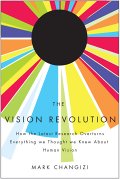 In his 2009 book The Vision Revolution, Mark Changizi explains how human colour perception evolved to allow us to see the subtle changes in skin tone that correlate with changes in blood flow and blood oxygenation. Why would we want to do this? Because changes in skin tones indicate emotions silently, allowing us to read the minds of others. An interesting point that arises from this theory, he explains, is that it is impossible to answer the question: What colour is my skin? Aside from the apparently superficial, but spectrally irrelevant, differences in skin colour between races, skin has no easy colour definition. Grass is obviously green, on a cloudless day the sky looks blue (usually), roses are red, violets are blue (well, actually they’re purple).
In his 2009 book The Vision Revolution, Mark Changizi explains how human colour perception evolved to allow us to see the subtle changes in skin tone that correlate with changes in blood flow and blood oxygenation. Why would we want to do this? Because changes in skin tones indicate emotions silently, allowing us to read the minds of others. An interesting point that arises from this theory, he explains, is that it is impossible to answer the question: What colour is my skin? Aside from the apparently superficial, but spectrally irrelevant, differences in skin colour between races, skin has no easy colour definition. Grass is obviously green, on a cloudless day the sky looks blue (usually), roses are red, violets are blue (well, actually they’re purple).
The colours of everything but skin are easy to describe. But, your skin? Whatever race you are you don’t think of your own skin as actually being the colour that people of different skin hue use to describe it. Caucasians aren’t white nor are they pink, blacks isn’t black, nor brown, brown. In fact, to the individual or the group that share skin hue, their skin has no colour, it is neutral. But, at the same time any human skin can take on almost any colour from pinks, blues, greens, yellows, browns, purples, whites…given applied pressure, temperature changes, illness etc.
Changizi argues that the colour of our skin being neutral in this way, having no single word to describe its colour means that we can perceive the subtlest of changes in skin tone associated with emotions, illness, embarrassment etc. It is the same in the sense that our saliva has no taste, but the slightest bitterness in the mouth is immediately obvious, just as our skin normally feels neither hot nor cold, but the forehead of someone with a fever just one degree hotter than us will feeling scorching hot, and just as our noses don’t generally detect the odour of our own bodies.
Fundamentally, we perceive ourselves as being at a neutral, baseline position to our senses. But, does this neutrality of
personal perception extend beyond skin colour and body odour? It occurred to me that perhaps it does and that this is the origin of so many issues. For example, we all have an “accent”, but we perceive it as being neutral until we are relocated from our home town to somewhere they speak differently. During my time working in the US the natives were forever commenting on my “English accent”, albeit a Geordie one. But, those same natives confronted with the reality of their own “American accent” were reluctant to accede that they had any accent at all!
So, if one’s accent is to one’s own perception, neutral then so might be one’s perception of the place where one is born, where one lives, the things one likes, the things one dislikes, political views, peccadilloes, kinks and perversions, religious standpoint etc. All “neutral” to you, but “an accent”, a deviation from the norm, to everyone else. Everyone knows someone more left or right than themselves, kinkier, odder…
The same probably applies to musical taste, taste in food, assessment of right and wrong…maybe this underpins the spread of memes within a society and how such “received wisdom” becomes culturally ingrained in pockets of community and spreads only farther afield through extreme intellectual intervention, or more commonly, violent persuasion.
In fact, I cannot think of any aspect of life that is not covered by our seeing ourselves as neutral and everyone else and everything everyone else does or believes in as being above or below our “neutral” baseline. Could this baseline perception be the origin of all debates, arguments and wars?
I asked Changizi what he thought of my little extension of his theory. This is what he had to say: “I totally agree! It’s worth a book of its own!” He added that, “Fleshing out the full extent to which it pervades everything would be utterly fascinating and mind-blowing.” But, conceded that he probably wasn’t the one to write that particular book.